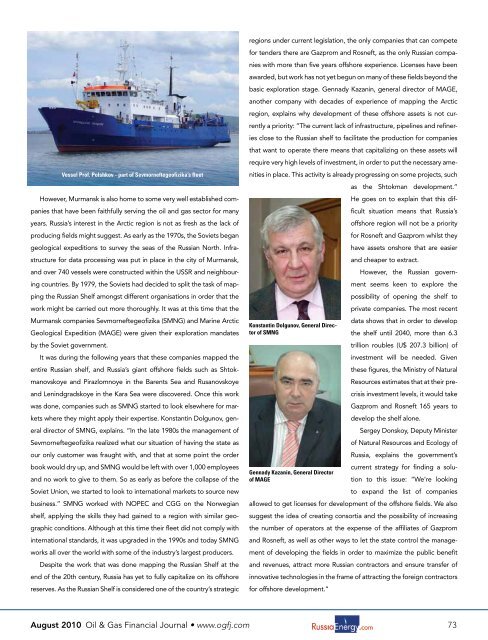Russia - Oil & Gas Financial Journal
Russia - Oil & Gas Financial Journal
Russia - Oil & Gas Financial Journal
You also want an ePaper? Increase the reach of your titles
YUMPU automatically turns print PDFs into web optimized ePapers that Google loves.
Vessel Prof. Polshkov - part of Sevmorneftegeofizika’s fleet<br />
However, Murmansk is also home to some very well established companies<br />
that have been faithfully serving the oil and gas sector for many<br />
years. <strong>Russia</strong>’s interest in the Arctic region is not as fresh as the lack of<br />
producing fields might suggest. As early as the 1970s, the Soviets began<br />
geological expeditions to survey the seas of the <strong>Russia</strong>n North. Infrastructure<br />
for data processing was put in place in the city of Murmansk,<br />
and over 740 vessels were constructed within the USSR and neighbouring<br />
countries. By 1979, the Soviets had decided to split the task of mapping<br />
the <strong>Russia</strong>n Shelf amongst different organisations in order that the<br />
work might be carried out more thoroughly. It was at this time that the<br />
Murmansk companies Sevmorneftegeofizika (SMNG) and Marine Arctic<br />
Geological Expedition (MAGE) were given their exploration mandates<br />
by the Soviet government.<br />
It was during the following years that these companies mapped the<br />
entire <strong>Russia</strong>n shelf, and <strong>Russia</strong>’s giant offshore fields such as Shtokmanovskoye<br />
and Pirazlomnoye in the Barents Sea and Rusanovskoye<br />
and Lenindgradskoye in the Kara Sea were discovered. Once this work<br />
was done, companies such as SMNG started to look elsewhere for markets<br />
where they might apply their expertise. Konstantin Dolgunov, general<br />
director of SMNG, explains. “In the late 1980s the management of<br />
Sevmorneftegeofizika realized what our situation of having the state as<br />
our only customer was fraught with, and that at some point the order<br />
book would dry up, and SMNG would be left with over 1,000 employees<br />
and no work to give to them. So as early as before the collapse of the<br />
Soviet Union, we started to look to international markets to source new<br />
business.” SMNG worked with NOPEC and CGG on the Norwegian<br />
shelf, applying the skills they had gained to a region with similar geographic<br />
conditions. Although at this time their fleet did not comply with<br />
international standards, it was upgraded in the 1990s and today SMNG<br />
works all over the world with some of the industry’s largest producers.<br />
Despite the work that was done mapping the <strong>Russia</strong>n Shelf at the<br />
end of the 20th century, <strong>Russia</strong> has yet to fully capitalize on its offshore<br />
reserves. As the <strong>Russia</strong>n Shelf is considered one of the country’s strategic<br />
regions under current legislation, the only companies that can compete<br />
for tenders there are Gazprom and Rosneft, as the only <strong>Russia</strong>n companies<br />
with more than five years offshore experience. Licenses have been<br />
awarded, but work has not yet begun on many of these fields beyond the<br />
basic exploration stage. Gennady Kazanin, general director of MAGE,<br />
another company with decades of experience of mapping the Arctic<br />
region, explains why development of these offshore assets is not currently<br />
a priority: “The current lack of infrastructure, pipelines and refineries<br />
close to the <strong>Russia</strong>n shelf to facilitate the production for companies<br />
that want to operate there means that capitalizing on these assets will<br />
require very high levels of investment, in order to put the necessary amenities<br />
in place. This activity is already progressing on some projects, such<br />
as the Shtokman development.”<br />
He goes on to explain that this difficult<br />
situation means that <strong>Russia</strong>’s<br />
offshore region will not be a priority<br />
for Rosneft and Gazprom whilst they<br />
have assets onshore that are easier<br />
and cheaper to extract.<br />
However, the <strong>Russia</strong>n government<br />
seems keen to explore the<br />
possibility of opening the shelf to<br />
private companies. The most recent<br />
data shows that in order to develop<br />
Konstantin Dolgunov, General Director<br />
of SMNG<br />
the shelf until 2040, more than 6.3<br />
trillion roubles (U$ 207.3 billion) of<br />
investment will be needed. Given<br />
these figures, the Ministry of Natural<br />
Resources estimates that at their precrisis<br />
investment levels, it would take<br />
Gazprom and Rosneft 165 years to<br />
develop the shelf alone.<br />
Sergey Donskoy, Deputy Minister<br />
of Natural Resources and Ecology of<br />
<strong>Russia</strong>, explains the government’s<br />
current strategy for finding a solution<br />
to this issue: “We’re looking<br />
Gennady Kazanin, General Director<br />
of MAGE<br />
to expand the list of companies<br />
allowed to get licenses for development of the offshore fields. We also<br />
suggest the idea of creating consortia and the possibility of increasing<br />
the number of operators at the expense of the affiliates of Gazprom<br />
and Rosneft, as well as other ways to let the state control the management<br />
of developing the fields in order to maximize the public benefit<br />
and revenues, attract more <strong>Russia</strong>n contractors and ensure transfer of<br />
innovative technologies in the frame of attracting the foreign contractors<br />
for offshore development.”<br />
August 2010 <strong>Oil</strong> & <strong>Gas</strong> <strong>Financial</strong> <strong>Journal</strong> • www.ogfj.com 73














